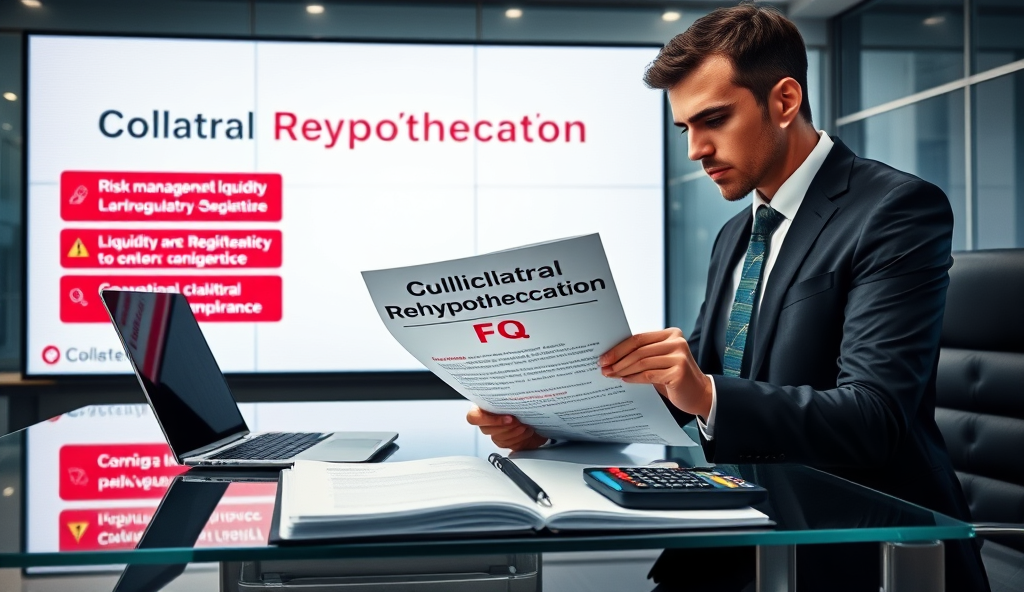Introduction to Collateral Rehypothecation
Collateral rehypothecation has become a cornerstone of modern financial markets, enabling institutions to maximize liquidity while minimizing idle assets. For example, prime brokers often reuse client-posted collateral to secure their own borrowing needs, creating a chain of credit that fuels trading activities.
This practice gained prominence after the 2008 financial crisis when regulators scrutinized its risks, yet it remains integral to global markets. In Europe alone, rehypothecation volumes exceeded €1.2 trillion in 2022, highlighting its systemic importance despite tighter oversight.
Understanding how rehypothecation works requires examining its legal framework and operational mechanics, which we’ll explore next. The interplay between liquidity benefits and counterparty risks makes this a critical topic for financial professionals navigating complex market structures.
Key Statistics

Definition of Collateral Rehypothecation
Collateral rehypothecation has become a cornerstone of modern financial markets enabling institutions to maximize liquidity while minimizing idle assets.
Collateral rehypothecation refers to the practice where financial institutions reuse client-posted collateral—such as securities or cash—for their own purposes, typically to secure loans or cover trading exposures. This mechanism transforms idle assets into active liquidity, as seen when prime brokers leverage client collateral to facilitate short selling or repo transactions, amplifying market activity while maintaining credit relationships.
Legally, rehypothecation occurs under specific agreements where clients grant their brokers limited rights to repledge assets, often capped at 140% of client liabilities in jurisdictions like the UK. The practice differs from simple collateral pledging by creating layered ownership claims, which contributed to Lehman Brothers’ collapse when $22 billion in rehypothecated assets became entangled in bankruptcy proceedings.
Understanding these legal distinctions and operational parameters is crucial before examining how rehypothecation works in financial markets, where its liquidity benefits must be weighed against systemic risks. The 2008 crisis demonstrated how excessive rehypothecation can create opaque chains of exposure, prompting reforms that still permit its use within defined boundaries.
How Collateral Rehypothecation Works in Financial Markets
Legally rehypothecation occurs under specific agreements where clients grant their brokers limited rights to repledge assets often capped at 140% of client liabilities in jurisdictions like the UK.
In practice, collateral rehypothecation operates through a chain of transactions where prime brokers repledge client assets—often equities or bonds—as collateral for their own borrowing needs, typically in repo markets or margin lending. For example, a hedge fund’s posted securities might be reused by a broker to secure a short-term loan from another institution, creating liquidity while maintaining the original credit exposure.
The process hinges on legal agreements like the ISDA Master Agreement, which specify rehypothecation limits and client protections, such as the UK’s 140% cap relative to client liabilities. Market data shows that pre-2008, rehypothecation volumes exceeded $4 trillion globally, but post-crisis reforms like Dodd-Frank now require clearer disclosure and risk management.
This layered reuse of collateral amplifies market efficiency but introduces complexity, as seen when Lehman’s collapse froze $22 billion in rehypothecated assets. Understanding these mechanics sets the stage for examining the key parties involved in rehypothecation chains, from clients to clearinghouses.
Key Parties Involved in Collateral Rehypothecation
Prime brokers gain significant liquidity advantages by reusing client collateral with JPMorgan estimating a 15-20% reduction in funding costs through optimized rehypothecation strategies.
At the core of collateral rehypothecation chains are prime brokers like Goldman Sachs or JPMorgan, which intermediate between hedge funds and lenders while managing legal agreements such as the ISDA Master Agreement referenced earlier. These institutions typically control 60-80% of global rehypothecation activity, leveraging client assets to secure funding in repo markets while adhering to jurisdictional limits like the UK’s 140% cap.
Hedge funds and asset managers act as initial collateral providers, often unaware their pledged securities may be reused multiple times—a practice that contributed to the $22 billion freeze during Lehman’s collapse. Meanwhile, clearinghouses and counterparty banks form the downstream recipients, relying on rehypothecated assets to meet margin requirements or facilitate derivatives trades, creating interdependencies that amplify systemic risk.
Regulators like the SEC and FCA oversee this ecosystem, enforcing post-crisis reforms such as Dodd-Frank’s disclosure mandates to mitigate the opacity that once allowed $4 trillion in pre-2008 rehypothecation volumes. This multi-layered involvement sets the stage for examining how financial institutions capitalize on these arrangements, which we’ll explore next.
Benefits of Collateral Rehypothecation for Financial Institutions
While collateral rehypothecation boosts liquidity and reduces costs it introduces counterparty risk when multiple parties claim the same assets as seen during Lehman Brothers' collapse where $22 billion in client assets were entangled.
Prime brokers gain significant liquidity advantages by reusing client collateral, with JPMorgan estimating a 15-20% reduction in funding costs through optimized rehypothecation strategies. This practice allows institutions to meet $2.1 trillion in daily global repo market demands while maintaining lean balance sheets.
Hedge funds benefit through lower borrowing costs, as prime brokers typically pass on 30-50% of rehypothecation-derived savings via reduced margin requirements or favorable financing terms. For example, Goldman Sachs’ 2022 reports showed clients saved $780 million annually through such arrangements.
The system enhances market liquidity by enabling up to 3x greater securities utilization compared to static collateral pools, though this efficiency comes with inherent risks we’ll examine next regarding counterparty exposures and regulatory constraints. Clearinghouses particularly depend on this liquidity to process $7 trillion in daily derivatives trades.
Risks Associated with Collateral Rehypothecation
Financial institutions should implement daily reconciliation systems like those mandated by UK post-Brexit rules as manual tracking of Deutsche Bank’s €290 billion rehypothecated assets proves insufficient during market volatility.
While collateral rehypothecation boosts liquidity and reduces costs, it introduces counterparty risk when multiple parties claim the same assets, as seen during Lehman Brothers’ collapse where $22 billion in client assets were entangled. The practice also creates systemic vulnerabilities, with the Bank for International Settlements warning that 40% of rehypothecated collateral chains exceed three transfers, amplifying contagion risks during market stress.
Operational risks emerge when prime brokers fail to track rehypothecated assets accurately, exemplified by MF Global’s 2011 misuse of $1.6 billion in client funds. These risks are compounded by jurisdictional differences, as UK clients face unlimited rehypothecation versus US SEC Rule 15c3-3’s 140% cap, creating cross-border enforcement challenges.
Such vulnerabilities have prompted regulators to tighten oversight, which we’ll explore next in examining the evolving global framework governing collateral rehypothecation practices. These measures aim to balance the system’s liquidity benefits with necessary safeguards against the risks highlighted here.
Regulatory Framework Governing Collateral Rehypothecation
Global regulators have implemented divergent approaches to collateral rehypothecation, with the EU’s SFTR requiring detailed transaction reporting while the US maintains its 140% cap under SEC Rule 15c3-3. The Basel III framework introduced liquidity coverage ratios that indirectly limit rehypothecation by mandating high-quality liquid asset holdings.
These measures aim to address the systemic risks highlighted earlier, particularly the BIS findings on extended collateral chains, by enhancing transparency and reducing interconnectedness. The UK’s post-Brexit reforms retain unlimited rehypothecation but now require daily client asset reconciliations, a direct response to the MF Global case.
As regulations evolve, firms must navigate complex cross-border compliance challenges, which we’ll see illustrated in the next section’s practical examples. This patchwork of rules reflects the ongoing tension between market efficiency and financial stability.
Examples of Collateral Rehypothecation in Practice
In 2012, JPMorgan Chase rehypothecated $546 billion of client collateral, leveraging it for proprietary trading and securities lending, demonstrating how US firms operate under the 140% SEC cap. European banks like Deutsche Bank, subject to SFTR reporting, disclosed rehypothecating €290 billion in 2021, with detailed transaction trails addressing regulators’ transparency concerns.
Hedge funds frequently engage in rehypothecation through prime brokerage agreements, where Goldman Sachs might repledge 85% of client assets to secure cheaper financing, while UK-based funds face daily reconciliation checks post-Brexit. This practice illustrates the regulatory divergence discussed earlier, with US flexibility contrasting with EU oversight.
The 2008 Lehman Brothers collapse revealed extreme rehypothecation risks when $50 billion in client assets became untraceable across global jurisdictions, directly influencing current UK reconciliation rules. Such cases underscore why misconceptions persist about collateral safety, a topic we’ll clarify next.
Common Misconceptions About Collateral Rehypothecation
Many assume rehypothecated collateral remains fully protected, yet the Lehman Brothers case showed how $50 billion in client assets vanished due to inadequate tracking across jurisdictions, disproving this notion. While US firms like JPMorgan operate under SEC caps, the 140% limit doesn’t eliminate counterparty risk, as seen when collateral chains break during market stress.
Another fallacy is that rehypothecation always boosts liquidity, but over-leveraging—such as Goldman Sachs repledging 85% of client assets—can amplify systemic risks if underlying collateral values plummet. Post-Brexit UK reconciliation rules exist precisely to prevent such scenarios, yet gaps persist in global frameworks.
Some believe regulatory reporting like SFTR guarantees transparency, yet Deutsche Bank’s €290 billion in rehypothecated assets still requires manual oversight to ensure accurate tracing. These misconceptions highlight why proactive risk management, which we’ll explore next, remains critical for financial professionals navigating rehypothecation.
Best Practices for Managing Collateral Rehypothecation Risks
Financial institutions should implement daily reconciliation systems like those mandated by UK post-Brexit rules, as manual tracking of Deutsche Bank’s €290 billion rehypothecated assets proves insufficient during market volatility. Diversifying counterparty exposure beyond SEC’s 140% limit—as JPMorgan does—reduces concentration risk when collateral chains fracture.
Stress-testing collateral values against scenarios like Goldman Sachs’ 85% repledging helps prevent liquidity shortfalls during market downturns. Firms should adopt blockchain-based tracking solutions to enhance transparency beyond SFTR reporting requirements, particularly for cross-border transactions where Lehman Brothers’ $50 billion loss occurred.
Establishing clear rehypothecation agreements with clients, including opt-out clauses and regular audits, builds trust while mitigating legal risks. These measures create a robust framework for navigating rehypothecation’s complexities, which we’ll summarize in our final analysis.
Conclusion on Collateral Rehypothecation
Collateral rehypothecation remains a powerful yet complex tool in financial markets, offering liquidity benefits while introducing counterparty risks, as discussed in earlier sections. The 2008 financial crisis highlighted its systemic dangers, with Lehman Brothers’ collapse showing how excessive rehypothecation can amplify market instability.
Regulatory frameworks like the EU’s EMIR and the US’s Dodd-Frank Act have since imposed stricter limits, but regional variations persist, requiring careful due diligence. For example, UK prime brokers often operate under FCA guidelines, while Asian markets may follow local securities lending rules.
Understanding these nuances helps financial professionals navigate rehypothecation agreements safely, balancing efficiency with risk management. As markets evolve, staying informed on legal and operational best practices remains critical for mitigating unintended consequences.
Frequently Asked Questions
What are the key regulatory differences in collateral rehypothecation between the US and EU?
The US enforces a 140% cap under SEC Rule 15c3-3 while the EU requires detailed transaction reporting under SFTR. Tip: Use compliance tools like Bloomberg Regulatory to track jurisdictional requirements.
How can financial institutions mitigate counterparty risk in collateral rehypothecation chains?
Diversify counterparty exposure and implement daily reconciliation systems. Tool: Adopt blockchain solutions like HQLAx for real-time collateral tracking.
What operational risks arise from collateral rehypothecation and how can they be managed?
Inaccurate asset tracking can lead to losses as seen in MF Global's case. Tip: Use automated platforms like TriOptima for collateral management.
How does collateral rehypothecation impact hedge fund financing costs?
Prime brokers pass 30-50% of savings to clients via reduced margin requirements. Tool: Negotiate terms using ISDA Master Agreement templates.
What lessons from Lehman Brothers' collapse apply to modern rehypothecation practices?
The $22 billion asset freeze highlighted the need for transparent tracking. Tip: Implement UK-style daily client asset reconciliations.





